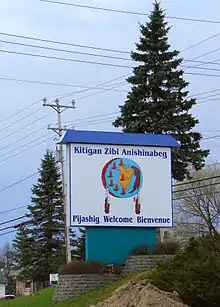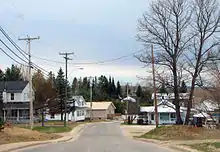Kitigan Zibi
Kitigan Zibi (also known as River Desert, and designated as Maniwaki 18 until 1994) is a First Nations reserve of the Kitigan Zibi Anishinabeg First Nation, an Algonquin band. It is situated near the confluence of the Désert and Gatineau Rivers, and borders south-west on the Town of Maniwaki in the Outaouais region of Quebec, Canada. Having a total area of 210 square kilometres (81 sq mi),[1] it is the largest Algonquin Nation in Canada in both area and population.[4]
Kitigan Zibi | |
|---|---|
First Nations Reserve | |
 Welcome sign | |
| Coordinates: 46°20′N 75°58′W | |
| Country | Canada |
| Province | Quebec |
| Region | Outaouais |
| Established | 1851 |
| Government | |
| • Type | Band council |
| • Chief | Jean-Guy Whiteduck |
| • Federal riding | Pontiac |
| • Prov. riding | Gatineau |
| Area | |
| • Total | 210.09 km2 (81.12 sq mi) |
| • Land | 172.93 km2 (66.77 sq mi) |
| Population | |
| • Total | 1,221 |
| • Density | 7.1/km2 (18/sq mi) |
| Time zone | UTC−05:00 (EST) |
| • Summer (DST) | UTC−04:00 (EDT) |
| Postal Code | J9E |
| Area code(s) | 819 |
| Website | www.kza.qc.ca |
_in_Kitigan_Zibi%252C_Quebec%252C_Canada.jpg.webp)

Present on the reserve are shops, an elementary and secondary school, a community hall, a health centre, police services, a youth centre, a retirement home, a cultural centre, and the CKWE 103.9 radio station.[4][5]
Toponymy
Kitigàn can be translated from Algonquin as "garden," "cultivated land" or "cleared land." This name may have originated as a reference to a clearing made by the Hudson's Bay Company for the establishment of its post, dependencies, and the adjoining garden.[6]
Geography
The reserve is bounded by the Eagle River along its west side, by the Désert River on the north side, and the Gatineau River on the east side. Most of its development is along or near Highway 105, while forest still covers much of the reserve. It is also home to 13 fresh water lakes with areas in excess of 250,000 square metres (2,700,000 sq ft; 25 ha; 62 acres) and approximately 29 smaller lakes and streams located throughout the territory.
Fish species found within these waters include walleye, pike, bass, trout, carp, catfish, and fresh water sturgeon. Mammals found within the reserve include beaver, muskrat, fisher, marten, mink, otter, bobcat, lynx, cougar, deer, black bear, wolf, and moose.
History
The history of the reserve is closely linked to that of the Town of Maniwaki, which developed concurrently.
In the first half of the 19th century, Algonquins of the mission at Lake of Two Mountains, under the leadership of Chief Pakinawatik, came to the area of the Désert River. Shortly after, in 1832, the Hudson's Bay Company followed them and installed a trading post at the mouth of this river (now within the municipal boundaries of Maniwaki). A decade later, Missionary Oblates of Mary Immaculate established the mission of Notre-Dame-du-Desert and, from 1849, they demanded of the authorities the demarcation of a township in order to establish a reserve for the Algonquins. Chief Pakinawatik, along with other leaders, journeyed by canoe on three separate occasions to Upper Canada (Toronto) and negotiated the terms for the setting aside of the reserve land. The township limits were drawn in 1850 and given the name of Maniwaki by the Oblates at this time.[6] In Algonquin language, the place was identified as Kitigànsìpì or Kitigàn Zìbì, meaning "Garden River."[7]
Legally established in 1851, the reserve was demarcated in 1853. In the decree implementing it, the reserve was called "Manawaki" (after mani aki meaning "Mary's Land") and also "River Desert". The name "Kitigan Zibi" came to replace the other two on September 24, 1994, when the band council gave this title to the reserve.[6]
Because of land claim settlements in the late 1990s, small portions of land of the Town of Maniwaki were added to Kitigan Zibi. The federal government concluded, on 18 March 2019, an agreement to pay the Kitigan Zibi community $116 million, settling 29 claims for Indian reserve land appropriated between 1873 and 1917 for the town site of Maniwaki.[8] The same community filed in December 2016 a claim in Ontario Superior Court, claiming it never surrendered and still owns the land in Ottawa on which Parliament of Canada stands.[9]
Concerned about the disinterest of its youth in their own language, the community has decided to reintroduce the teaching of the Algonquin language in school.[6]
Demographics

As of July 2020, the registered population of the Kitigan Zibi Anishinabeg First Nation is 3,513 members, of whom 1,624 live on the Kitigan Zibi reserve, 25 live on another reserve or other band crown land, and 1,864 live off reserve.[10]
| Canada census – Kitigan Zibi community profile | |||
|---|---|---|---|
| 2016 | 2006 | ||
| Population: | 1221 (4.3% from 2011) | 1165 (7.8% from 2001) | |
| Land area: | 172.93 km2 (66.77 sq mi) | 172.07 km2 (66.44 sq mi) | |
| Population density: | 7.1/km2 (18/sq mi) | 6.8/km2 (18/sq mi) | |
| Median age: | 35.9 (M: 30.8, F: 40) | 33.4 (M: 28.9, F: 36.2) | |
| Total private dwellings: | 505 | 482 | |
| Median household income: | $46,241 | $26,944 | |
| References: 2016[11] 2006[12] earlier[13] | |||
Canada Census data before 2001:[14]
- Population in 1996: 969 (+41.9% from 1991: adjusted for boundary change)
- Population in 1991: 563
Language
As of the 2016 census of those living on the Kitigan Zibi reserve:[15]
- 20.7% learned their indigenous language as their first language.
- 17.4% speak an indigenous language at home.
- 31% have knowledge of an indigenous language.
- 59.5% speak only English out of the official languages.
- 2.4% speak only French out of the official languages.
- 37.6% speak both English and French.
List of chiefs

- Chief Antoine Pakinawatik - 1854-1874
- Chief Peter Tenasco - 1874-1884, 1890–1896
- Chief Simon Odjick - 1884-1890
- Chief Louizon Commanda - 1896-1899
- Chief John Tenasco - 1899-1911
- Chief Michael Commanda - 1911-1917
- Chief John Cayer - 1917-1920
- Chief John B. Chabot - 1920-1924, 1939–1951
- Chief Vincent Odjick - 1927-1933
- Chief Patrick Brascoupe - 1933-1936
- Chief Abraham McDougall - 1936-1939
- Chief William Commanda - 1951-1970
- Chief Ernest McGregor - 1970-1976
- Chief Jean Guy Whiteduck - 1976-2006
- Chief Stephen McGregor - 2006-2008
- Chief Gilbert Whiteduck - 2008-2015
- Chief Jean-Guy Whiteduck - 2015–present day
Culture and tourism
The Kitigan Zibi Pow Wow is held annually on the first weekend of June. The Kitigan Zibi Cultural Centre has a number of exhibits, cultural artifacts, paintings, and photographs relating to the Algonquin culture and history. A living museum, Mawandoseg Kitigan Zibi, is dedicated to traditional Anishinaabeg way of life.[4]
References
- "Kitigan Zibi Anishinabe". First Nation Profiles. Indigenous and Northern Affairs Canada. 2020-03-11. Retrieved 2020-08-27.
- "Band Council". Kitigan Zibi Anishinabe. Kitigan Zibi Anishinabe. 2020. Retrieved 2020-08-27.
- "Kitigan Zibi, IRI, Quebec". Census Profile, 2016 Census. Statistics Canada. 2017-11-29. Retrieved 2020-08-27.
- "The Algonquin Communities: Kitigan Zibi Anishinabeg". Anishinabe Nation. Algonquin Anishinabeg Nation Tribal Council. 2016. Retrieved 2020-08-26.
- "Health & Social Services". Kitigan Zibi Anishinabe. Kitigan Zibi Anishinabe. 2020. Retrieved 2020-08-27.
- "Kitigan Zibi (Réserve indienne)" (in French). Commission de toponymie du Québec. Retrieved 2012-10-26.
- "Maniwaki (Ville)" (in French). Commission de toponymie du Québec. Retrieved 2012-10-26.
- https://www.cbc.ca/news/canada/ottawa/kitigan-zibi-land-claims-settled-1.5061515
- National Post, 8 Dec. 2016 https://nationalpost.com/news/politics/algonquin-bands-lawsuit-declares-ownership-of-parliament-hill-amid-stalled-land-claim-talks
- "Kitigan Zibi Anishinabeg Registered Population". First Nation Profiles. Indigenous and Northern Affairs Canada. 2020-03-11. Retrieved 2020-08-27.
- "2016 Community Profiles". 2016 Canadian Census. Statistics Canada. February 21, 2017. Retrieved 2020-08-27.
- "2006 Community Profiles". 2006 Canadian Census. Statistics Canada. March 30, 2011. Retrieved 2012-10-26.
- "2001 Community Profiles". 2001 Canadian Census. Statistics Canada. February 17, 2012.
- Statistics Canada: 1996 census
- "Kitigan Zibi Anishinabeg Languages Characteristics". First Nation Profiles. Indigenous and Northern Affairs Canada. 2020-03-11. Retrieved 2020-08-27.
External links
| Wikimedia Commons has media related to Kitigan Zibi. |
